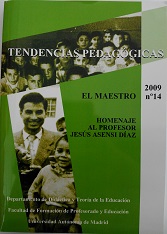Keywords:
Stress, Labor satisfaction, Wage satisfaction, University professors/teachers.Abstract
SWS-Survey was applied to a 53 professors’ sample from Autonomous University of Madrid (UAM) as an ad hoc instrument to measure their stress and support levels (available resources). The research’s emphasis was marked in labor-organizational area, performing as educators at university level. Results were compared to another 193 individuals’ sample compound by their homologues from National Autonomous University of Mexico (UNAM) and one more with 48 individuals from Metropolitan University in Education Sciences (UMCE) of Santiago de Chile. Found evidence suggests that UAM professors have wide personal and social resources to overcome stress in those areas; nevertheless, they show high stress levels at work and low organizational support level; besides, they perceive unsatisfactory labor and wage conditionsDownloads
References
·Buendía, J. y Ramos, F. (2001). Empleo, estrés y salud. Madrid: Editorial Pirámide.
·Cooke, R.A. y Rousseau, D.M. (1984). Stress and Strain From Family Roles and Work Role Expectations, Journal of Applied Psychology, 69, 252-260.
·Dunham, J. (1976). Stress Situations and Responses: Stress in Schools. Hempstead: Editorial Hemel.
· Fimian, M. J. y Santoro, M. T. (1981). Correlates of Occupational Stress as Reported by FullTime Education Teachers. I. Sources of Stress II. Manifestations of Stress. USA: Educational Information Research Centre.
·Heneman, H. y Donald, S. (1985). Satisfacción de pago: su naturaleza multi-dimensional y su medida. Diario Internacional de Psicología 20. Holanda.
·Herzberg, F.; Mausner, B y Snyderman B. (1992). The motivation to work. New Bruns-wick, New Jersey: Transaction Publishing.
·Ibarra, Eduardo (2003). Universidad en la penumbra y más allá: notas para comprender la gran transformación de la universidad y discutir su porvenir como institución de la sociedad. Educación Superior: Cifras y Hechos, Centro de Investigaciones Interdisciplinarias en Ciencias
y Humanidades, UNAM, Año 3, No. 14-15, mayo-agosto, pp 13-17.
·Kyriacou, Chris (2003). Antiestrés para profesores. Barcelona: Octaedro.
·Milstein, M. M. y Golaszwski, J. T. (1985). Effects of Organisationally-based and individuallybased
Stress Management Efforts in Elementary School Settings. California, USA: Editorial Urban Education.
·Needle, R. H.; Griffin, T. y Svendsen, R. (1981). Occupational Stress: Coping and health problems of teachers. The Journal of School Health, 51, 175-181.
·Payne, M.A. y Furnham, A. (1987). Dimensions of Occupational Stress in West Indian Secondary
school teachers. British Journal of Educational Psychology. 41-50.
· Pearlin, L. y Turner, H.A. (1987). The Family as Context of the Stress Process, en Kasl, S.V. y Cooper, C.L. (Comps.), Stress and Health: Issues in Research Metodology, Chichester, Wiley
·Phillips, B. L. y Lee, Y. J. (1980). The Changing Role of American Teacher: Current and Future Sources of Stress. En C.L. Cooper y J. Marsahal (comps), White Collar and Professional Stress. Chichester, Wiley.
·Stewart, F. y Jeffrey G. (2001). Trabajo y familia: ¿aliados o enemigos? México: Editorial Oxford
University.
·Tellenbeck, S.; Brenner, O. S. y Lofgren, H. (1983). Teacher Stress: Exploratory Model Building.
Journal of Occupational Psychology, 56: 19-33.
· Travers, C. y Cooper, C. (1997). El estrés de los profesores: la presión en la actividad docente.
Barcelona: Paidós.
·Williams, S. y Lesley, C. (2004). Manejo del estrés en el trabajo: plan de acción detallado para profesionales. México D.F.: Editorial El Manual Moderno.
